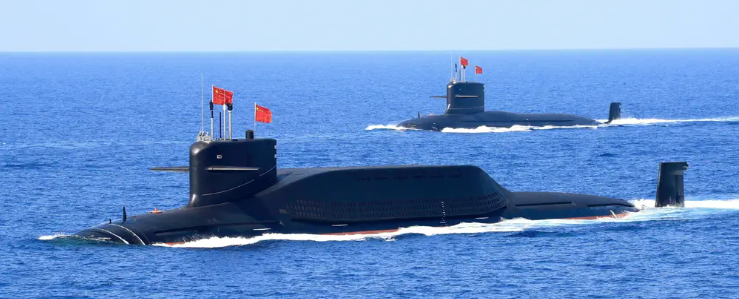China’s laser-propelled stealth subs
China closing in on laser-propelled fast, stealth subs
AsiaTimes by Gabriel Honrada • April 23, 2024
China may be moving closer to the holy grail of submarine stealth technology – a propulsion system with no mechanical moving parts. Such technology would eliminate all detectable vibrations, allowing for unprecedented underwater stealth capabilities.
The South China Morning Post (SCMP) reported that Chinese scientists have found a way to significantly improve the efficiency of laser propulsions, which could one day drive submarines.
China and US locked in underwater race to produce new generation of submarines driven by less-detectable propulsion technologies
The report says the new technology can produce nearly 70,000 newtons of thrust, using 2 megawatts of laser power emitted through the submarine’s coating of optical fibers, each thinner than a human hair.
The SCMP report notes that the technology works by leveraging supercavitation generated by laser pulses vaporizing seawater, which can significantly reduce water resistance. It claims that the “underwater fiber laser-induced plasma detonation wave propulsion” eliminates detectable mechanical noise, enabling greater stealth.
To be sure, laser propulsion technology is not new. Twenty years ago, Japanese scientists introduced the concept of using lasers to create plasma in water and harness the detonation wave produced by plasma expansion for propulsion.
However, the idea didn’t progress as the scientists found it challenging to generate a directional driving force as the detonation wave expands in all directions from a single point.
Despite that setback, China and several other countries have funded research on using tiny spherical metal particles to create a force on submarines.

hypersonics, electronic warfare and in key undersea capabilities
Detonation waves can propel particles in a specific direction, exerting an opposite force on the submarine. Still, the current efficiency is too low to be practical, with 1 watt of laser power generating only one-millionth of a newton of thrust.
However, the SCMP report says Chinese scientists from Harbin Engineering University have designed a laser engine that improves the efficiency of converting lasers into thrust by three to four orders of magnitude.
They modified the fibers by adding a gun barrel-like device with a U-shaped interface and used a pair of barrels to bombard particles in the working medium. They also added designed protruding structures inside the barrel to minimize interaction and internal friction between shock waves.
While SCMP says that a submarine nuclear reactor produces over 150 megawatts, which is enough for the laser propulsion system, it notes various design challenges such as heat dissipation by the optical fibers, resilience in high power and high salinity environments, and the alignment of optical fiber emission apertures with the submarine’s anechoic panels.
In contrast to China, the US has researched magnetohydrodynamic drive (MHD) technology since the 1960s as an alternative to mechanical propulsion. MHD technology uses magnetic fields and electrically conducting fluids to generate thrust, potentially offering several advantages over traditional propeller-driven systems.
In a May 1991 article for the peer-reviewed Naval Engineers Journal, Daniel Swallom and other writers note that MHD offers increased stealth, maneuverability and survivability, eliminates detectable noise from mechanical components and enables higher payload capabilities due to efficient use of space.
Swallom and others also outlined the optimal design for MHD thrusters. They used mathematical modeling to evaluate various neutrally buoyant configurations of MHD thrusters that could seamlessly integrate with existing submarine power plants. They also proposed a segmented, annular thruster optimized for performance in generic attack submarines.
However, they also highlighted significant design challenges, such as developing appropriate superconducting magnets and structural support for MHD thrusters. These require advancements in superconducting materials and cryogenic systems while ensuring neutral buoyancy to avoid interference with the submarine’s operational capabilities.
Despite that, the US Defense Advanced Research Projects Agency (DARPA) reported in May 2023 that it had initiated the 42-month Principles of Undersea Magnetohydrodynamic Pumps (PUMP) program to advance MHD technology.
As with China’s laser propulsion technology, DARPA says that MHD propulsion has been successful on a small scale yet remains impractical due to the inability to generate powerful magnetic fields for high-efficiency pumps. It also mentions electrode corrosion and erosion problems due to contact with seawater.
However, DARPA says advances in the commercial nuclear fusion industry have enabled the production of rare-earth barium copper oxide (REBCO) magnets that could generate magnetic fields up to 20 Tesla that could give 90% MHD efficiency. This advancement would solve the problem of generating powerful magnetic fields for pumps, leaving electrode longevity the main challenge.
DARPA says it hopes to leverage material science advances in fuel cell and battery technology to reduce the formation of gas bubbles on electrode surfaces, which decreases efficiency and erodes electrode surfaces.
However, since MHD operates on the principle of magnetism, it may become more detectable by magnetic anomaly detection (MAD) systems.
Such advances could further the development of next-generation submarines, which may be all-electric with no mechanical moving parts in future. With advancements in battery technologies and air-independent propulsion (AIP), the possibility of all-electric military submarines is becoming increasingly feasible.
For more, see
37/44: China leads US in emerging technology
ASPI’s Critical Technology Tracker The global race for future power
In October 2022, Asia Times noted that lithium-ion batteries can significantly enhance submarines’ underwater endurance, acceleration and speed due to their higher energy density than traditional lead-acid batteries, faster charging rate, greater discharge speed and longer lifespan.
However, lithium-ion batteries have a significant drawback: they are prone to thermal runaway and fire hazards. This risk is high in submarines, where a single overheating cell can trigger a thermal runaway across the entire battery bank, resulting in devastating fires.
Iron and phosphate can be used instead of nickel and cobalt to solve the thermal runaway problem in lithium batteries, providing a safer and equally performing alternative. Submarine lithium-ion batteries can be made safer using hard carbon and ceramic coating for battery packaging.
Lithium-ion submarines are also possibly quieter than nuclear-powered ones. Nuclear submarines have unlimited range, but their constantly running coolant pumps can emit detectable noise. They also emit radiation traces that can be detected with specialized sensors.
Navies can pair lithium-ion batteries with fuel cells, which offsets the former’s limitations. However, fuel cells pose design challenges, primarily due to their means of storing hydrogen fuel and unproven technology.
Next-gen lithium-ion + fuel cell submarines, equipped with propulsion technologies such as laser propulsions and MHD, may have extreme endurance, incredibly quiet operation, fast acceleration and high dash speeds. However, cost and complexity are still issues for mainstreaming such designs.
“He shall lend to thee, and thou shalt not lend to him. He shall be the head, and thou shalt be the tail.”
“The Lord shall bring a nation against thee from far, from the end of the earth, as swift as the eagle flieth, a nation whose tongue thou shalt not understand,
“a nation of fierce countenance, which shall not regard the person of the old nor show favor to the young.
“And he shall eat the fruit of thy cattle and the fruit of thy land until thou be destroyed; he also shall not leave thee either corn, wine, or oil, or the increase of thy cattle, or flocks of thy sheep until he have destroyed thee.
“And he shall besiege thee in all thy gates until thy high and fortified walls come down wherein thou trusted, throughout all thy land; and he shall besiege thee in all thy gates throughout all thy land which the Lord thy God hath given thee,” Deuteronomy 28:44,49-51


